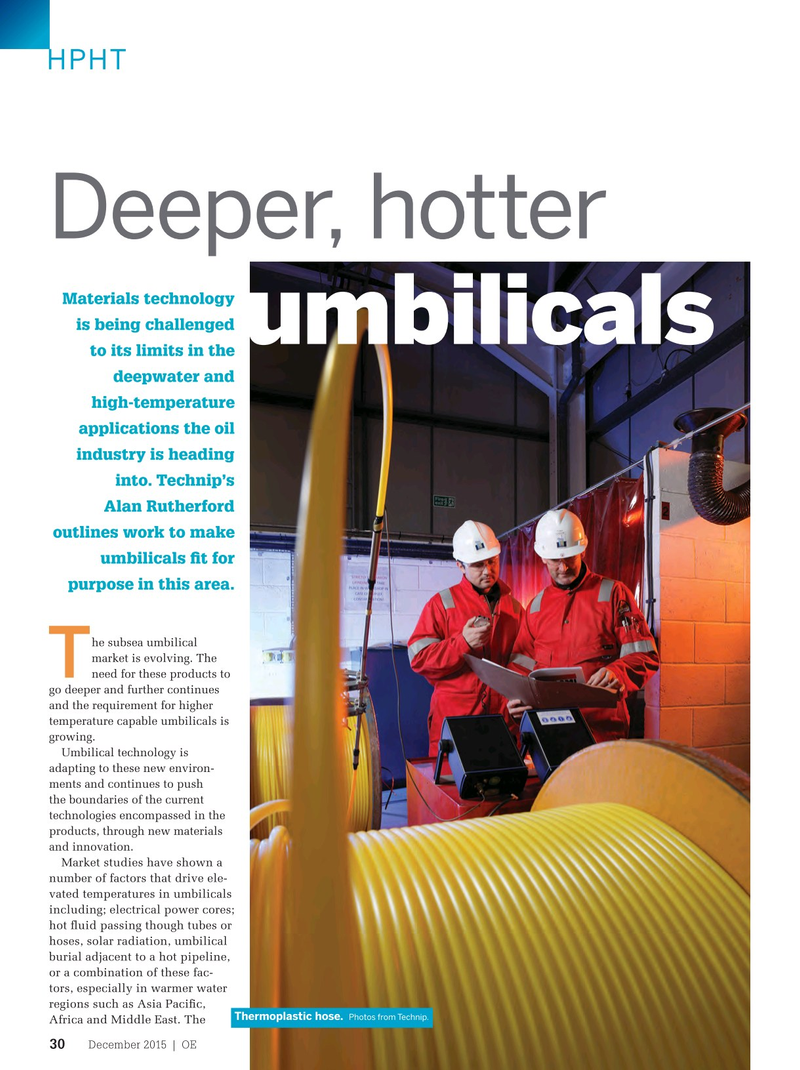
Page 28: of Offshore Engineer Magazine (Dec/Jan 2015)
Read this page in Pdf, Flash or Html5 edition of Dec/Jan 2015 Offshore Engineer Magazine
HPHT heat generated or experienced by an affected umbilical can lead to accepted temperature limits being exceeded for commonly used umbilical materials, resulting in de-rating of stress allow- ances or corrosion of metallic compo- nents, and mechanical degradation of polymers.
These factors leave umbilical manu- facturers faced with many challenges; how do we design umbilicals to with-
Deeper, hotter stand these temperatures? Can these materials last for 25 years in service?
Will new products be more cost ef? cient than current designs?
Materials technology
Facing these challenges led Technip is being challenged
Umbilicals to undertake several research umbilicals and development initiatives on new to its limits in the technologies to ensure we can create products that are not only high quality deepwater and but are also cost ef? cient for the current high-temperature market. applications the oil
Overcoming challenges
Materials used within traditional industry is heading thermoplastic umbilicals are able to into. Technip’s cope in a wide range of applications and environments, including low-temperature
Alan Rutherford and long-term continuous operations.
However, using these materials in high- outlines work to make temperature environments, especially umbilicals ? t for over long periods of time, can result in issues including; reduced collapse resis- purpose in this area.
tance due to material softening, reduced service life from degradation and dif- ? cultly in retaining the coupling on the he subsea umbilical end of the hose. In order to give the prod- market is evolving. The uct long term viability, a fundamental
T need for these products to change in all aspects of the hose design go deeper and further continues from liner material, reinforcement mate- and the requirement for higher rial, cover material and end ? tting design was required.
temperature capable umbilicals is To overcome the high temperature concerns in hose technol- growing. ogy, Technip Umbilicals has developed a new thermoplastic
Umbilical technology is hose design known as DUCOFlex HT (high temperature), creat- adapting to these new environ- ing a product which can operate continuously at temperatures ments and continues to push from -40°C to +80°C and is capable of sustaining intermittent the boundaries of the current use at temperatures from -50°C to +100°C for longer periods of technologies encompassed in the time, ensuring no degradation in performance.
products, through new materials Any new material must be more cost effective for future and innovation. developments compared to the alternative; super duplex stain-
Market studies have shown a less steel tubes or coated tubes, which have a higher component number of factors that drive ele- and manufacturing cost compare to standard thermoplastic vated temperatures in umbilicals hose. Also, the additional bene? ts from easier termination and including; electrical power cores; installation of thermoplastic umbilicals compared to steel tube hot ? uid passing though tubes or umbilicals needs to be preserved to ensure the overall cost hoses, solar radiation, umbilical advantage is maintained.
burial adjacent to a hot pipeline,
Bene? ts of the technology or a combination of these fac- tors, especially in warmer water Technip Umbilicals patented the use of the polyethylene regions such as Asia Paci? c, based liner technology DUCO? ex in 1994, which gave signi? -
Thermoplastic hose. Photos from Technip.
Africa and Middle East. The cant performance improvements in terms of ? uid permeation
December 2015 | OE oedigital.com 30 030_OE1215_HPHT2_Technip.indd 30 11/21/15 1:33 PM

 27
27

 29
29